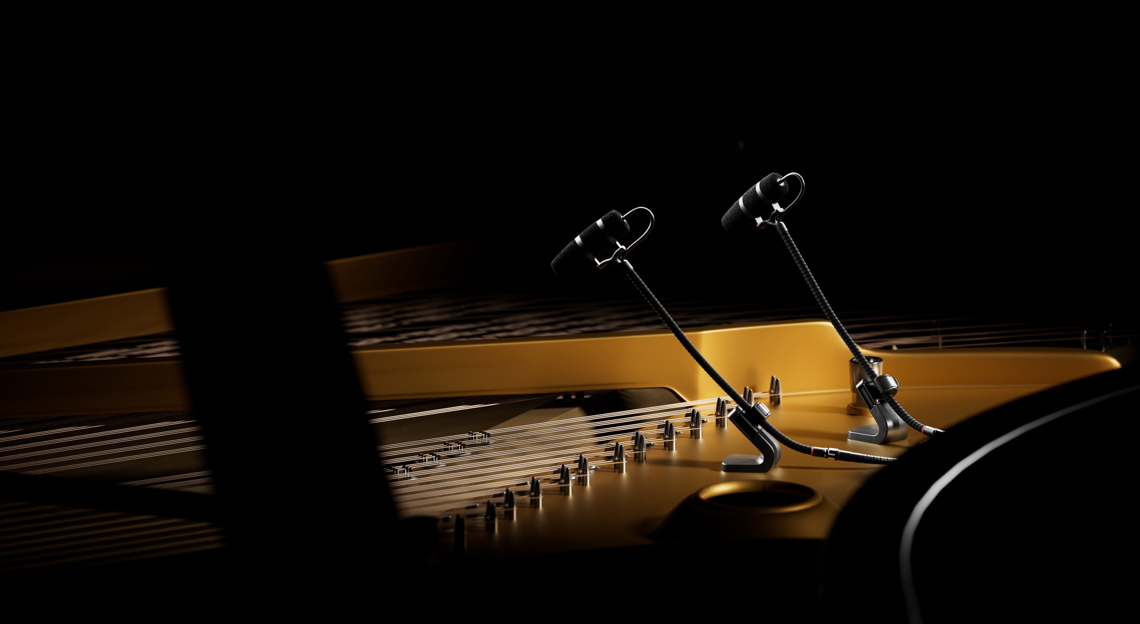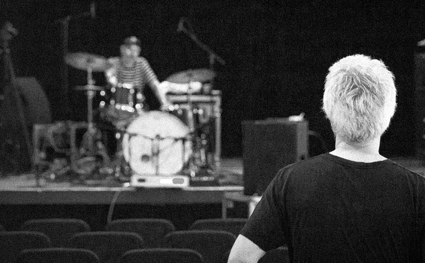How to mic a grand piano
Guidelines for miking the grand piano.

What to consider when miking a grand piano
A concert grand piano is among the largest and most versatile acoustical instruments in the world. Capturing the natural timbre and the full dynamics of an instrument of these proportions requires both skill and quality recording equipment. Furthermore, the grand piano interacts differently with each room in which it is placed.
Since no two rooms are alike, the recording method requires independent consideration in each situation and each location. Even the method with which the elegant instrument is played will influence the choice of miking technique. The grand piano is the king of instruments and, to ensure the best quality audio it deserves, microphone selection is of utmost importance.
Room acoustics
The room acoustics are such an important factor to consider when recording a concert grand piano. It is important to assess whether or not the room will do the instrument justice.
A concert grand piano is built for playing in concert halls, where the reverberation times normally are acoustically tuned between 0.9 seconds to 1.3 seconds at 500 Hz and the room volume is minimum 10,000 cubic meters. Concert halls specially designed for playing music from the ever-famous composer Wagner can even have reverberation times of around two seconds.
With the lid open, the concert grand piano is capable of giving a full musical experience to the audience throughout the hall. This must be taken into account if the location is a recording studio. Finding a good location with a well-tuned grand piano is the first – and hardest – thing to do.
The music
The choice of recording method also depends on the repertoire to be played. Classical piano music deserves a natural blend of ambience, but different composers all have their own characteristics, which leave more or less space for the ambience to influence the music. Many a record producer and sound engineer has added his own interpretation of the grand masters' notes while immortalizing their compositions through a pair of microphones.
Rhythmic music and jazz traditionally are played in different types of locations. Therefore, the listener's expectations of the timbre and ambiance are somewhat different. In many cases, it was the composer's intention that his work be replayed on a hi-fi system in the home environment. The room acoustics of the location in which the jazz piano has been recorded is then judged by different, and possibly less critical, criteria. To give the grand piano its unique timbre, the recording still needs to convey a sense of location, which will provide the listener with a sensation of being brought to the edge of their seat.
Classical piano music and AB stereo
Error loading Partial View script (file: ~/Views/MacroPartials/TaggedProducts.cshtml)When recording classical piano music, the finest results come out of two omnidirectional microphones like the ST4006A Stereo Pair or ST2006A Stereo Pair in an AB stereo setup in front of the grand piano.
The AB stereo pair is placed on the side of the piano to give the listener an illusion of being a part of the audience. By adjusting the distance to the piano and the exact placement next to the piano, the amount of ambience and timbre of the instrument can be tuned.
Placements near the center of the piano from the arch and within two meters apart are often preferred. The microphones are normally spaced between 40 to 60 cm apart and the stereo image can be chosen in a way so the pianist is seated to the left or so the bass key strokes appear to the left and the treble key strokes to the right. The height of the stereo boom is quite low, 1.2 m to 1.5 m above the boundary on which the piano is placed. By pointing the microphones to the open lid of the piano, the sound reflecting on the inner side of the lid will be brightened up and a beautiful depth will be added to the recording. Rhythmic piano music and directional microphones.
Rhythmic piano music and directional microphones
In rhythmic music and jazz, all of the musical instruments are more or less used to create a beat or percussion. This is also true of the grand piano, which makes it all the more important to capture the attack of the player. The beautiful sound of the mechanics and the hands against the keys are often preferred over a precise stereo perspective. (The "produced" sound is more sought after for instruments intended for the harmonies. The pace and rhythm of those instruments do not leave space for reverberation, which could cause the music to sound muddy and unclear if recorded in the same approach as rhythmic instruments.)
The goal with a percussive instrument is to create a recording that is tight and fast, which allows the instrument to sound incredibly good. To achieve this goal, the microphones need to be placed closer to the piano, maybe even inside the open lid, over the strings or the hammers. Only here is it possible to capture the attack and roughness of the versatile king of instruments. To distinguish the room reflections and the reverberation, the use of directional microphones is recommended.
Two extremely successful stereo set-ups using directional microphones inside a grand piano are:
1. An ORTF stereo set-up approximately 12 inches (30 cm) over the strings at the mid frame. The microphones are pointed 45° downwards and at the pianist.
2. Two parallel cardioid microphones spaced less than 24 inches (60 cm) apart and positioned over the mid hammers pointing 45° downwards and at the pianist.
Error loading Partial View script (file: ~/Views/MacroPartials/TaggedProducts.cshtml)Both solutions are achievable with either a ST2011C Cardioid Stereo Pair with RSM Accessory Pack or a ST4011C Cardioid Stereo Pair with RSM Accessory Pack.
Please note: The sound pressure level inside a concert grand piano can exceed 130 dB SPL peak less than eight inches (20 cm) over the strings, so be careful when choosing microphone types.
For live use with PA
Error loading Partial View script (file: ~/Views/MacroPartials/TaggedProducts.cshtml)In acoustic environments where the piano is not the loudest sound source, such as in big bands, when other instruments are near or when monitoring systems playing very loud cover the stage, the ideal solution is to provide higher isolation with narrower microphone patterns and closer placements. Closing the piano lid or choosing a short stick is also useful for separation. A clip microphone allows flexible and close placement without needing to fight with stands. The 4099 CORE+ Stereo Microphone System is the obvious choice for this application.
Miking a piano with miniature microphones
Error loading Partial View script (file: ~/Views/MacroPartials/TaggedProducts.cshtml)With the SMK4061 Stereo Microphone Kit a number of useful piano set-ups can be achieved. This is a low-cost stereo kit, equally suited for project studios and for hidden mic setup on stage, using two high-quality 4061 Omnidirectional Miniature Microphones and a variety of mounting accessories for placement in and on the piano, with either an open or closed lid.
Miking a grand piano with DPA microphones
Error loading Partial View script (file: ~/Views/MacroPartials/TaggedProducts.cshtml)Place the 4061 miniature microphones in foam windscreens with the DMM0011 Magnet Microphone Holder in and around the sound holes of the piano. You can use two or three 4061s and create a balanced multi-dimensional sound with good front of house and monitor volume, along with recordability. Place one microphone in or near the high hole and another over the last octave of low strings (maybe the second to last octave). This method will give you high gain before feedback because of the close distance to the frame. It will also provide a thick, full-bodied midrange sound that often fits well into rhythmic genres.
Error loading Partial View script (file: ~/Views/MacroPartials/TaggedProducts.cshtml)Boundary layer mounts (BLM6000) are also included in the SMK4061 Stereo Mic Kit. Mount two BLM6000s inside the open piano lid to get a natural sound for recording. The pressure zone technique will “draw in” and accumulate the piano’s timbre nicely, while at the same time it will be very discrete in appearance. Placing the mounts directly on the sounding board under the strings gives a sharp pop sound for on-stage use with a penetrating “honky-tonk” sound color.
Error loading Partial View script (file: ~/Views/MacroPartials/TaggedProducts.cshtml)With the DMM0007 Universal Surface Mount for microphones, you can affix the microphones directly to the inside of the piano lid. This is also an almost invisible mounting technique. The microphone element is able to hang from its own integrated cable with the double-sided tape pads and the height/acoustic balance can be adjusted as needed. A well-balanced, open-sounded position is 12 to 16 inches (30 to 40 cm) above the piano, in front of the hammers, with approximately 24 inches (60 cm) between the microphones.








